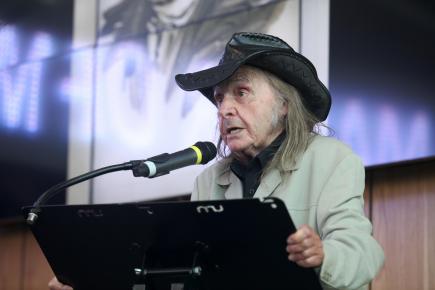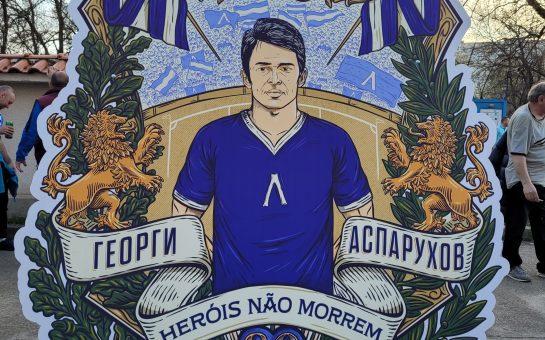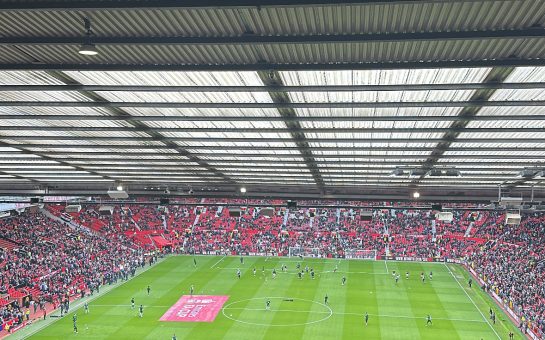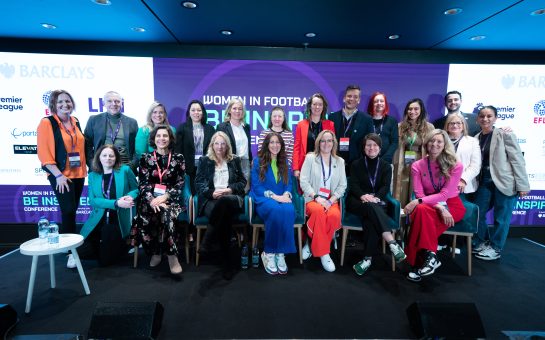A portrait of Sir Winston Churchill signed by the man himself has gone on public display at Manchester’s National Football Museum.
Produced by one of Britain’s leading sports artists, Paul Trevillion, the portrait was signed by Churchill in 1955 after he asked to meet the young artist.
Now 82, Paul had looked up to Churchill as a young boy living in Tottenham through World War II.
“When the war broke out I was five, I didn’t get evacuated and so I was there for the blitz,” Paul told MM.
“It was a very bad time because you never said to your friends ‘see you tomorrow’ because you just didn’t know if you would.
“We used to play football in the park and we’d all turn up and suddenly someone would say ‘where’s Terry, oh there was a bomb up there’ – it was a very worrying time.
“All this happened and the only thing I thought about through the blitz was Winston Churchill with his little smile and victory sign would beat Hitler – it was just a matter of time.”

UNVEILING: Paul appearing at the National Football Museum
On Churchill’s 80th birthday, an official portrait was commissioned with Graham Sutherland chosen to paint the former PM.
Hated by Churchill, the picture is thought to have been disposed of on the orders of his wife Lady Clementine.
“He said Sutherland’s painting was a ‘terrible, modernistic thing, and it’s nothing like me’,” Paul said.
“I thought the next year I’m going to give him a happy birthday.”
Paul, who was already producing drawings for a number of newspapers and magazines, showed his portrait to Austrian interior designer Laszlo Hoenig.
Laszlo had previously snubbed the chance to produce work for Nazi politician Joseph Goebbels and was advised to leave the country immediately.
The designer and architect later lost his mother and two sisters in the Holocaust and became one of Churchill’s many admirers.
Laszlo told Paul that his friend Bernard Sunley, a pioneer of Britain’s post-war reconstruction, could get the portrait to the man himself.
The property developer sent off the portrait to Churchill, along with a copy of Paul’s CV, and a few days later the phone rang.
“‘I heard ‘Is that Trevillion?” Paul told MM.
“He said ‘Winston here, I will be at the Bernard Sunley Buildings, Berkeley Square, on Wednesday – 10.30 – oblige’ and the phone went down.”
Happy Birthday Ronnie. But Rooney is still better looking…WR is the James Dean of football! pic.twitter.com/3FcVMVzvdX
— Paul Trevillion (@PaulTrevillion) February 5, 2016
On the day of meeting one of Britain’s most iconic leaders, Paul had dug out his best suit which had ‘seen better days, but was at least presentable’.
“We walked in, I saw him sitting there, and I thought will he get up and shake my hand – and he did,” said Paul.
“His hand was much smaller than I imagined and the first words he said were ‘when were you born?’”
“I told him 1934 and he asked me if I was a boy from the blitz.”
Paul says that Churchill, who had already proved to be tricky subject matter for Graham Sutherland, told him that he thought the picture was excellent work.
“I simply said ‘can you give me that in writing’ and he said he’d do better than that, he’d sign it,” said Paul.
“I couldn’t believe it.”
The young sports artist and Churchill found common ground in a love of football.
#England
Bobby Moore By Artist
Paul Trevillion pic.twitter.com/dJDE7FPkOj— Superb Footy Pics (@SuperbFootyPics) May 1, 2016
While Paul had dedicated his life to sketching his favourite players, Churchill became the first PM to present the FA Cup at Wimbledon in 1952.
Arsenal lost 1-0 to Newcastle after losing Welsh defender Walley Barnes to injury.
Paul said that although Churchill noted that he thought it was sad that Arsenal lost their left-back, he did not think that substitutions should ever be introduced to the game.
“He said ‘no, no, no, where will it end, they’ll want one, then two, then three, and how do you even know if a player is really injured?’”
Paul said that the former PM was concerned that the result of allowing substitutes would be ‘half a team training all week and then sitting on the bench to watch other players play’.
Substitutions would eventually be introduced to competitive matches in the 1965-66 season, the year Churchill died.
“What he said then is true today,” said Paul.
“You get players sat on the bench sulking their faces off, called on in the last ten minutes.”
Art was also on the agenda, of course.
Churchill took up painting at the age of 40 and is said to have rarely travelled without his paint box.
It is thought that he painted up to 500 landscape pieces, often giving them to friends as gifts.
US Presidents Roosevelt, Truman and Eisenhower all received views of Marrakesh from the former PM.
Paul Trevillion (Roy of the Rovers) the best sports artist in the world unveils his drawing of Churchill pic.twitter.com/nJ1rKJ9JNm
— Clare Tomlinson (@Clare1744) May 3, 2016
“He asked me how I’d done the painting and I told him that it was just pen and ink,” said Paul.
“‘Just practice pen and ink then’, he said – ‘become the master – do what Turner did’.
“He told me that Turner’s watercolours were so good that people thought they were oil paintings.
“He said ‘make people think your pen and ink are oil paintings, it’ll take you a lifetime but you’ll do it and you’ll be the first’.”
The artist, who has since developed one of the industry’s most distinct styles, has only ever practiced pen and ink since.
“When I left he didn’t get up this time, he just smiled and did a little victory sign,” said Paul.
“I looked at his face and then at my portrait and I thought – I’ve nailed him – I’ve got my own.”
The portrait of Sir Winston Churchill will eventually be sold, with Paul agreeing to donate a percentage to the National Football Museum – a registered charity which promotes the sport that has shaped his career.
“I never let school lessons get in the way of my education,” said the football fan.
“All I wanted to do was draw, so that’s all I ever did.
“Now I’m a bit of a hopeless case because I don’t read or write but I’m surrounded by people who believe in the art.
“I just draw – take the pencil away and I’m just Paul Trevillion, put one in my hand and I’m the artist.”
Image courtesy of Jason Lock, with thanks.


